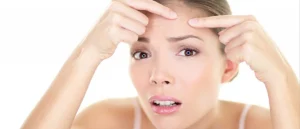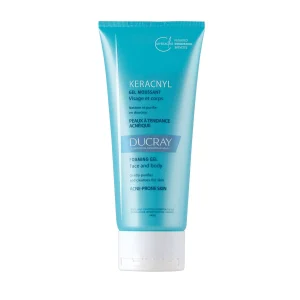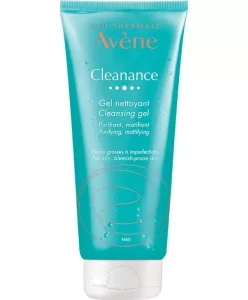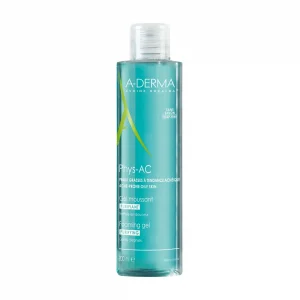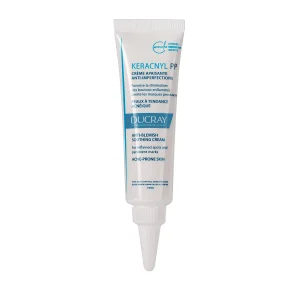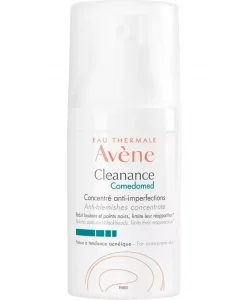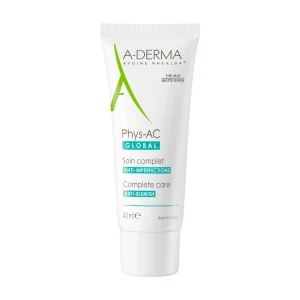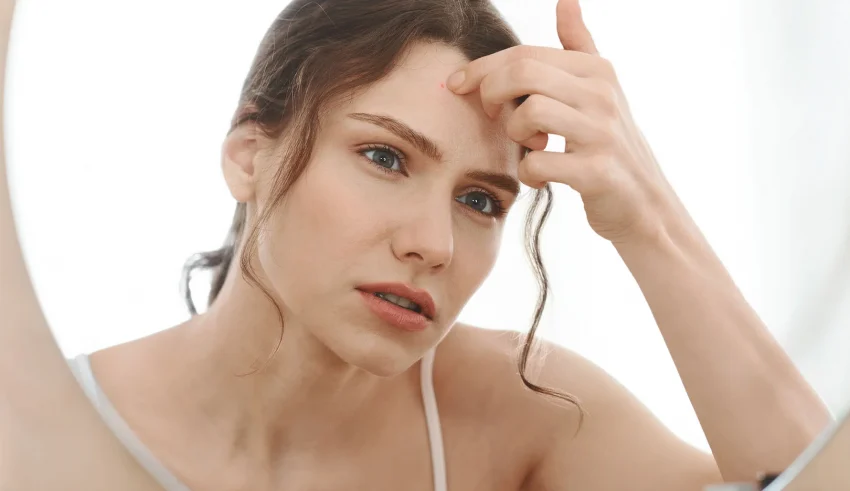
While acne can be frustrating on any part of the body, forehead acne is particularly bothersome because of its highly visible location on the face. As with other types of acne, breakouts that affect your forehead can be treated and prevented with the right combination of medication, skin care products, and good habits. Learn more about why forehead pimples are so common, and how to get rid of them for good in this article from The Dermo Lab in collaboration with the dermatologist and cosmetologist Dr. Irena Ivanovska.
What causes forehead acne?
According to Dr. Irena Ivanovska, excess sebum production, stress, poor hygiene, and hormonal changes are the most common factors in forehead acne.
- Excess sebum production. Forehead acne, like all acne symptoms, begins with excess oil produced by the sebaceous glands. This excess sebum, which is sent through the pores to protect and moisturize the skin, can sometimes clog pores on its way to the skin’s surface, creating a suitable environment for acne-causing bacteria.
- Stress. There is a link between stress and acne breakouts, but the reasons behind this link are still unclear.
- Hygiene. Not washing your hair and face regularly can lead to oily deposits on the forehead which promote acne.
- Hormonal changes. Acne is especially common during puberty, as hormone levels fluctuate dramatically during this time.
Using makeup on the forehead or wearing clothing such as hats can also irritate the forehead and cause acne. In addition, certain types of medications can cause acne as a side effect. This is the case with certain steroids, anticonvulsants, barbiturates, or lithium.
Is it safe to pop a pimple on the forehead?
You should never pop a pimple on your forehead or elsewhere on your face or body. By popping acne, you are introducing dirt from your fingers into your skin, which can lead to infection. If you pop a pimple, it will take longer to heal. Popping can also leave a permanent scar.
What are the different types of acne on the forehead?
Contrary to popular belief, not all acne is the same. From comedones to nodular acne, several types of acne can develop on your forehead:
1- Comedonal acne: This is a mild, non-inflammatory form of acne. Comedonal acne can be open or closed. When a comedo is closed, it is white in color and is called a whitehead. When a comedo is open, oxygen from the air can react with the debris clogging the follicle, giving it a dark color. These comedones are called blackheads.
2- Inflammatory acne: When bacteria develop inside a blackhead, it can become inflamed and irritated. Inflammatory acne is red in color, lifts from the skin, and can be painful to the touch. Common types of inflammatory acne are papules and pustules.
3- Nodular and cystic acne: When inflammatory acne becomes very severe, it is often called nodular or cystic acne. This type of acne can penetrate deep into the skin and leave permanent scars.
If you are prone to acne, you may notice several different types of acne lesions on your forehead and elsewhere on your face. It’s important to identify the type of acne you have so that it can be prevented and treated effectively.
How to cure forehead acne?
While acne on the forehead can be embarrassing, even the most severe breakouts can usually be treated with a combination of good skin care habits and medication.
1- Good skin care habits
Dr. Irena Ivanovska recommends a regular facial routine that includes a suitable facial cleanser and moisturizer, in addition to local creams.
A facial cleanser, which helps clean your skin and remove excess oil, can often help control mild acne that may develop on your forehead and elsewhere on your face. If you are prone to acne, wash your forehead and other affected areas of your face with a mild cleanser twice a day.
For best results, choose a cleanser that is free of harsh and potentially irritating chemicals. Here are the best acne facial cleansers to keep your skin clean and blemish-free.
Ducray Keracnyl Foaming Gel
Eau Thermale Avène Cleanance Cleansing Gel
A-Derma Phys-AC Foaming Gel
In addition to cleansing, applying your topical acne treatment is another essential way to reduce inflamed pimples, remove excess oil, limit bacterial adhesion, and moisturize your skin.
According to Dr. Irena Ivanovska, an acne cream on the forehead should contain a keratolytic agent such as salicylic acid, benzoyl peroxide, niacinamide, and also the newest active ingredient, comedoclastin.
Here are a series of recommendations for the best topical acne treatment that will give your pimples a double punch.
Ducray Keracnyl PP Anti-Blemish Soothing Cream
Eau Thermale Avène Cleanance Comedomed
A-Derma Phys-AC Global
2- Prescription treatment
Forehead acne treatment consists of several prescription medications. Depending on the type and severity of your acne, your healthcare provider may prescribe one or more of the medications listed below:
- antibiotics
- retinoids
- birth control pills
- anti-androgenic agent
Antibiotics and retinoids come in cream form. You can also take them in pill form.
If you have severe acne on the forehead, it’s important to talk to your healthcare provider or make an appointment with a dermatologist. When used as prescribed, medications help treat the most severe and stubborn acne on the forehead and other parts of the face.
If you want to know how to get rid of acne scars on the forehead, Dr. Irena Ivanovska points out that laser treatments, chemical peels, radiofrequency microneedling can all be effective.
How to prevent forehead acne?
Maintaining a good level of personal hygiene is the best way to prevent acne on the forehead. Dr. Irena Ivanovska recommends adopting a healthy lifestyle, avoiding processed and fried foods, and using a non-greasy sunscreen.
Other acne prevention tips include:
- Avoid wearing hats or tight clothing that covers the forehead
- Avoid using harsh skin products on the forehead
- Use face scrubs to cleanse the skin deeply
- Avoid touching or scratching pimples on the forehead
- Remove makeup before going to bed
- Wash your face immediately after any activity that causes sweat on the forehead
- Wash your hands regularly throughout the day
- Avoid prolonged exposure to the sun
In conclusion
Dr. Irena Ivanovska notes that forehead acne can vary from 2 to 6 months, sometimes even longer, especially during puberty.
Although it can be embarrassing, it is usually easily treated with over-the-counter products, prescription medications, or both. Once you’ve treated your acne, making small changes to your habits is often enough to make it go away for good.
If you have mild or occasional forehead acne, consider one of the treatments listed above. For more severe acne, it’s best to talk to your doctor.
Last Updated on April 16, 2024
